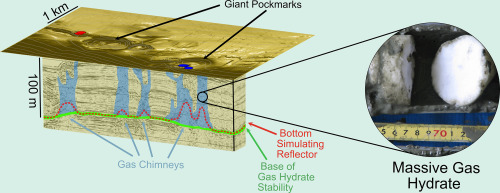当前位置:
X-MOL 学术
›
Chem. Geol.
›
论文详情
Our official English website, www.x-mol.net, welcomes your
feedback! (Note: you will need to create a separate account there.)
Magmatic fluids play a role in the development of active gas chimneys and massive gas hydrates in the Japan Sea
Chemical Geology ( IF 3.6 ) Pub Date : 2020-03-01 , DOI: 10.1016/j.chemgeo.2020.119462 Glen T. Snyder , Yuji Sano , Naoto Takahata , Ryo Matsumoto , Yoshihiro Kakizaki , Hitoshi Tomaru
Chemical Geology ( IF 3.6 ) Pub Date : 2020-03-01 , DOI: 10.1016/j.chemgeo.2020.119462 Glen T. Snyder , Yuji Sano , Naoto Takahata , Ryo Matsumoto , Yoshihiro Kakizaki , Hitoshi Tomaru

|
Abstract The Earth's marine continental margins hold significant amount of carbon in the form of gas hydrate which can interact dynamically with seawater and the atmosphere and potentially influence global climate. It is generally assumed that degradation of organic matter, through either biogenic or thermogenic processes, is responsible for the majority of the gas hydrate presently found in these deposits. We present stable isotope and noble gas results from gas hydrates in the eastern margin of the Japan Sea and compare them with previously published data regarding gases which are found nearby in deep hydrocarbon wells associated with Early Miocene igneous and sedimentary rocks. Our results show that most of the gases which accumulate in the hydrate can be described as a mixture between a deeply-sourced methane-rich thermogenic/crustal source (TC), a methane-rich admixture of biogenic gases with relatively shallow air-saturated seawater (BASW) and a methane-poor magmatic-mantle source (MM). The presence of hydrate with a mantle 3He/4He signatures indicates that fluids enriched in mantle gases are responsible for the mobilization of thermogenic gas within active Japan Sea chimney structures. The growth of primary hydrate at shallow marine sediment depths is ongoing, as is the cycling of gas to hydrate which is eventually buried and dissociated at the base of the gas hydrate stability zone, leading to large pockmark structures.
中文翻译:

岩浆流体在日本海活动气烟囱和块状天然气水合物的发育中发挥作用
摘要 地球的海洋大陆边缘含有大量以天然气水合物形式存在的碳,这些碳可以与海水和大气发生动态相互作用,并可能影响全球气候。人们普遍认为,目前在这些矿床中发现的大部分天然气水合物是通过生物成因或热成因过程进行的有机物降解造成的。我们提供了日本海东缘天然气水合物的稳定同位素和稀有气体结果,并将它们与先前公布的有关在与早中新世火成岩和沉积岩相关的深烃井附近发现的气体的数据进行比较。我们的研究结果表明,大多数积聚在水合物中的气体可以描述为深源富含甲烷的热成因/地壳源 (TC)、生物成因气体的富含甲烷的混合物与相对浅的空气饱和海水的混合物。 (BASW) 和贫甲烷岩浆地幔源 (MM)。具有地幔 3He/4He 特征的水合物的存在表明富含地幔气体的流体是活跃日本海烟囱结构内热成因气体的流动的原因。浅海沉积物深度处原生水合物的生长仍在继续,气体到水合物的循环也是如此,最终在天然气水合物稳定带的底部被埋藏和解离,导致大的麻点结构。富含甲烷的生物气与相对浅的空气饱和海水 (BASW) 和贫甲烷岩浆地幔源 (MM) 的混合物。具有地幔 3He/4He 特征的水合物的存在表明富含地幔气体的流体是活跃日本海烟囱结构内热成因气体的流动的原因。浅海沉积物深度处原生水合物的生长仍在继续,气体到水合物的循环也是如此,最终在天然气水合物稳定带的底部被埋藏和解离,导致大的麻点结构。富含甲烷的生物气与相对浅的空气饱和海水 (BASW) 和贫甲烷岩浆地幔源 (MM) 的混合物。具有地幔 3He/4He 特征的水合物的存在表明富含地幔气体的流体是活跃日本海烟囱结构内热成因气体的流动的原因。浅海沉积物深度处原生水合物的生长仍在继续,气体到水合物的循环也是如此,最终在天然气水合物稳定带的底部被埋藏和解离,导致大的麻点结构。
更新日期:2020-03-01
中文翻译:

岩浆流体在日本海活动气烟囱和块状天然气水合物的发育中发挥作用
摘要 地球的海洋大陆边缘含有大量以天然气水合物形式存在的碳,这些碳可以与海水和大气发生动态相互作用,并可能影响全球气候。人们普遍认为,目前在这些矿床中发现的大部分天然气水合物是通过生物成因或热成因过程进行的有机物降解造成的。我们提供了日本海东缘天然气水合物的稳定同位素和稀有气体结果,并将它们与先前公布的有关在与早中新世火成岩和沉积岩相关的深烃井附近发现的气体的数据进行比较。我们的研究结果表明,大多数积聚在水合物中的气体可以描述为深源富含甲烷的热成因/地壳源 (TC)、生物成因气体的富含甲烷的混合物与相对浅的空气饱和海水的混合物。 (BASW) 和贫甲烷岩浆地幔源 (MM)。具有地幔 3He/4He 特征的水合物的存在表明富含地幔气体的流体是活跃日本海烟囱结构内热成因气体的流动的原因。浅海沉积物深度处原生水合物的生长仍在继续,气体到水合物的循环也是如此,最终在天然气水合物稳定带的底部被埋藏和解离,导致大的麻点结构。富含甲烷的生物气与相对浅的空气饱和海水 (BASW) 和贫甲烷岩浆地幔源 (MM) 的混合物。具有地幔 3He/4He 特征的水合物的存在表明富含地幔气体的流体是活跃日本海烟囱结构内热成因气体的流动的原因。浅海沉积物深度处原生水合物的生长仍在继续,气体到水合物的循环也是如此,最终在天然气水合物稳定带的底部被埋藏和解离,导致大的麻点结构。富含甲烷的生物气与相对浅的空气饱和海水 (BASW) 和贫甲烷岩浆地幔源 (MM) 的混合物。具有地幔 3He/4He 特征的水合物的存在表明富含地幔气体的流体是活跃日本海烟囱结构内热成因气体的流动的原因。浅海沉积物深度处原生水合物的生长仍在继续,气体到水合物的循环也是如此,最终在天然气水合物稳定带的底部被埋藏和解离,导致大的麻点结构。











































 京公网安备 11010802027423号
京公网安备 11010802027423号